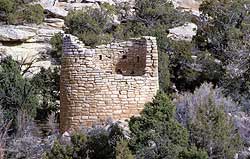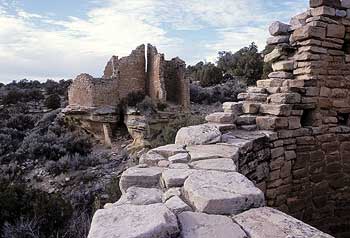| All Photos |
The earliest historic record of Cutthroat Castle dates from 1929, when it was documented by archeologist Paul Martin. The site was added to Hovenweep National Monument in 1956. Unlike the other Hovenweep pueblos, the structures at Cutthroat Castle are not located immediately at the head of a canyon, but further downstream. The Cutthroat Group also appears to have a large number of kivas (Puebloan ceremonial structures) relative to other building types. Puebloan kivas are usually built into the earth, and are typically round. An exception is the kiva incorporated into Cutthroat Castle, which rests on top of a boulder.
 In Puebloan religion, the kiva is a structure that connects with different worlds. The floor is related to the world below, and is usually built below ground level. The entrance to a typical kiva is through the roof, which relates to the world above. Cutthroat Castle Kiva is surrounded by another structure or room. Access into this surrounding structure appears to have been from below the boulder on which the kiva is built, through a split in the boulder.
In Puebloan religion, the kiva is a structure that connects with different worlds. The floor is related to the world below, and is usually built below ground level. The entrance to a typical kiva is through the roof, which relates to the world above. Cutthroat Castle Kiva is surrounded by another structure or room. Access into this surrounding structure appears to have been from below the boulder on which the kiva is built, through a split in the boulder.
Though it may appear isolated, the ancestral Puebloan population at Cutthroat Castle was quite large. Natural resources in the area, particularly the forest of piñon and juniper trees, provided the Puebloans with a variety of useful materials. Piñon seeds were a food source rich in calories and protein. Piñon sap or pitch was used as a waterproof sealant for baskets. Shredded juniper bark was used for clothing and sandals. Trees were burned in fires and used as building materials. In fact, by counting the tree rings present in structural timbers, archeologists can determine exactly when these sites were built.
Researchers studying prehistoric diets have found sagebrush flowers, seeds, and leaves in the Puebloans’ waste. As a minor part of their diet, sagebrush would have been a good source of iron and Vitamin C. In larger amounts, it kills intestinal parasites. Quartz pebbles from stream beds provided material for stone tools. When these rocks are broken using another rock or a piece of antler, they have edges as sharp as glass. Puebloans shaped these hard rocks into tools such as knives, scrapers, and projectile points.
The geology of the surrounding landscape produces springs and seeps. In these canyons, permeable Dakota sandstone rests on top of impermeable Burro Canyon shale. Water from rain and snow soaks through the sandstone, but is forced to flow outward when it meets the shale. When this water reaches the wall of a canyon it forms a spring. For the Puebloans, these canyons with seeps and springs were the ideal place to locate a village.
